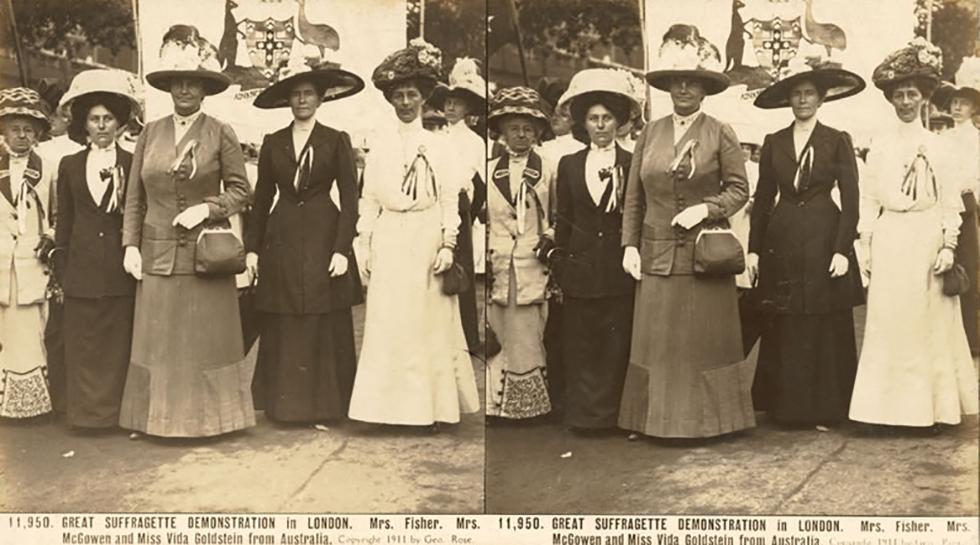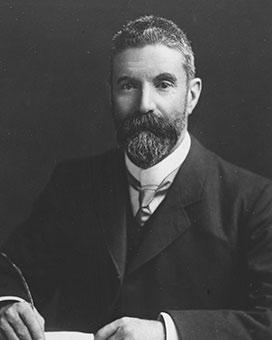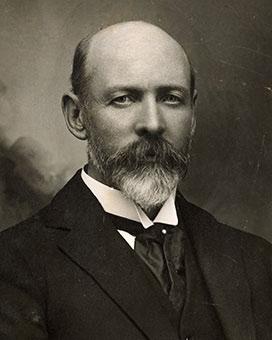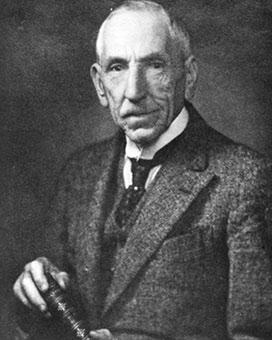For 5 years from her marriage on 31 December 1901, Margaret Fisher managed the family home in Gympie, Queensland in Andrew Fisher’s Wide Bay electorate. In 1907, when Fisher became leader of the Federal Parliamentary Labor Party, the family moved to Melbourne. Their new house was the impressive Oakleigh Hall at 50 Dinsdale Street, in Melbourne’s East St Kilda. The house soon became a venue for political gatherings, and meetings of ministers and parliamentarians. When Andrew Fisher became prime minister in 1908, the Caucus meeting to form his first Cabinet was held there on 12 November 1908.

Stereoscopic photograph of Margaret Fisher (centre) with Emily McGowen, Vida Goldstein, Lady Cockburn (wife of South Australian Premier) and Lady Stout (wife of former New Zealand Prime Minister) lead marchers bearing Australia's Coat of Arms in the 1911 suffrage demonstration in London. By permission National Library of Australia Pic/6941
Mrs Fisher was the first to manage a prime ministerial residence, as none of the previous prime ministerial spouses had filled this role. Jane Barton, Ada Watson and Florence Reid had all maintained their family homes in Sydney. Alfred and Pattie Deakin were the only prime ministerial family to live in Melbourne, and Deakin only invited his few closest colleagues to their home.
The purchase of Oakleigh Hall apparently strained the Fishers’ finances. Their daughter recalled the house was a constant source of financial anxiety to her father, whose ‘Scotch head’ avoided any extravagance. Though entirely the financial responsibility of the Fishers, the house also served parliament and party during Fisher’s 3 prime ministerial terms.
Mrs Fisher fulfilled the public roles of prime ministerial spouse overseas, as well as at home. Like Jane Barton and Pattie Deakin, she made an official visit to London as part of the Australian delegation to the coronation of King George V and Queen Mary in 1911. She took part in the many events throughout Britain associated with the coronation and the Imperial Conference.
Unlike her predecessors, Mrs Fisher also took part in a political demonstration. Before the coronation, a huge suffrage procession marked the progress of a bill for votes for British women. Mrs Fisher joined organisers at the head of the Australian and New Zealand contingent in the 40,000 strong procession through London. The contingent marched behind a magnificent ‘Trust the women’ banner designed by artist Dora Meeson for a 1908 demonstration. As both British prime ministerial spouses from 1908 to 1922, Margot Asquith and Margaret Lloyd George, were as firmly opposed to women’s suffrage as their husbands, this direct action suggests the many ways that Australia expressed independence in its status as a British dominion.
At the Imperial Conference, Andrew Fisher was the sole labour prime minister, making the couple celebrities for British Labour parliamentarians, led by Fisher’s longtime friend, Keir Hardie. This novel position had its awkward moments for Mrs Fisher. She attended a Labour Party dinner on the same night she and Rosina Batchelor were to be presented at Court. Through an error, the 2 women were not cued to leave the dinner in time to change into their Court dress and drive to Buckingham Palace. Mrs Fisher was dubbed the ‘Yes, No Lady’ by reporters, scenting a scandal when she managed to never explain why she was presented instead some weeks later at Holyrood House, while the Fishers were in Scotland.
Sources
- Fisher, Margaret, 'Andrew Fisher at home', Denis Murphy collection, UQFL129, Box 20, Fryer Library, University of Queensland.
- Oldfield, Audrey, Women’s Suffrage in Australia, Cambridge University Press, Melbourne, 1992.





